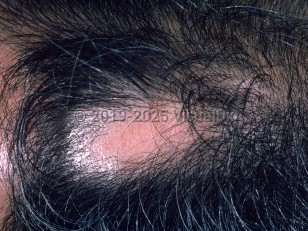Traumatic alopecia in Adult
Alerts and Notices
Important News & Links
Synopsis

Traumatic alopecia results from the forceful extraction of hair secondary to mechanical friction, pressure, or physical trauma. Types of traumatic alopecia include self-inflicted trichotillomania; traction alopecia from tight braids, ponytails, or hair-straightening practices; prolonged pressure on the scalp; and alopecia secondary to physical abuse. Traumatic alopecia associated with abuse can be challenging to distinguish from other forms of alopecia.
In traction alopecia, if the stimulus causing the traction is removed early, affected hair will recover. However, chronic long-term friction can cause permanent hair loss. Traction alopecia secondary to braids often results in hair loss on the scalp margin. It is more common in females and Black individuals due to hair-styling practices for tight braids or the use of chemical hair straighteners.
Trichotillomania is usually diagnosed in adolescents and preteens, although it also occurs in adults. It is characterized by irregular patches of alopecia without evidence of scarring. Adults with trichotillomania may have other comorbid diagnoses such as anxiety disorder, depression, or attention deficit hyperactivity disorder (ADHD).
Pressure-induced alopecia refers to hair loss induced by localized pressure on the scalp due to prolonged immobilization. This results in a focal area of hair loss occurring several days to weeks after the initial trigger. The alopecia may be nonscarring (if diagnosed early) or scarring (if diagnosis is delayed). Any age group may be affected.
Alopecia from abuse is classically associated with other signs of trauma such as scalp bruising and tenderness.
In traction alopecia, if the stimulus causing the traction is removed early, affected hair will recover. However, chronic long-term friction can cause permanent hair loss. Traction alopecia secondary to braids often results in hair loss on the scalp margin. It is more common in females and Black individuals due to hair-styling practices for tight braids or the use of chemical hair straighteners.
Trichotillomania is usually diagnosed in adolescents and preteens, although it also occurs in adults. It is characterized by irregular patches of alopecia without evidence of scarring. Adults with trichotillomania may have other comorbid diagnoses such as anxiety disorder, depression, or attention deficit hyperactivity disorder (ADHD).
Pressure-induced alopecia refers to hair loss induced by localized pressure on the scalp due to prolonged immobilization. This results in a focal area of hair loss occurring several days to weeks after the initial trigger. The alopecia may be nonscarring (if diagnosed early) or scarring (if diagnosis is delayed). Any age group may be affected.
Alopecia from abuse is classically associated with other signs of trauma such as scalp bruising and tenderness.
Codes
ICD10CM:
L65.9 – Nonscarring hair loss, unspecified
SNOMEDCT:
67488005 – Traumatic alopecia
L65.9 – Nonscarring hair loss, unspecified
SNOMEDCT:
67488005 – Traumatic alopecia
Look For
Subscription Required
Diagnostic Pearls
Subscription Required
Differential Diagnosis & Pitfalls

To perform a comparison, select diagnoses from the classic differential
Subscription Required
Best Tests
Subscription Required
Management Pearls
Subscription Required
Therapy
Subscription Required
References
Subscription Required
Last Reviewed:02/08/2020
Last Updated:04/10/2023
Last Updated:04/10/2023
Traumatic alopecia in Adult

